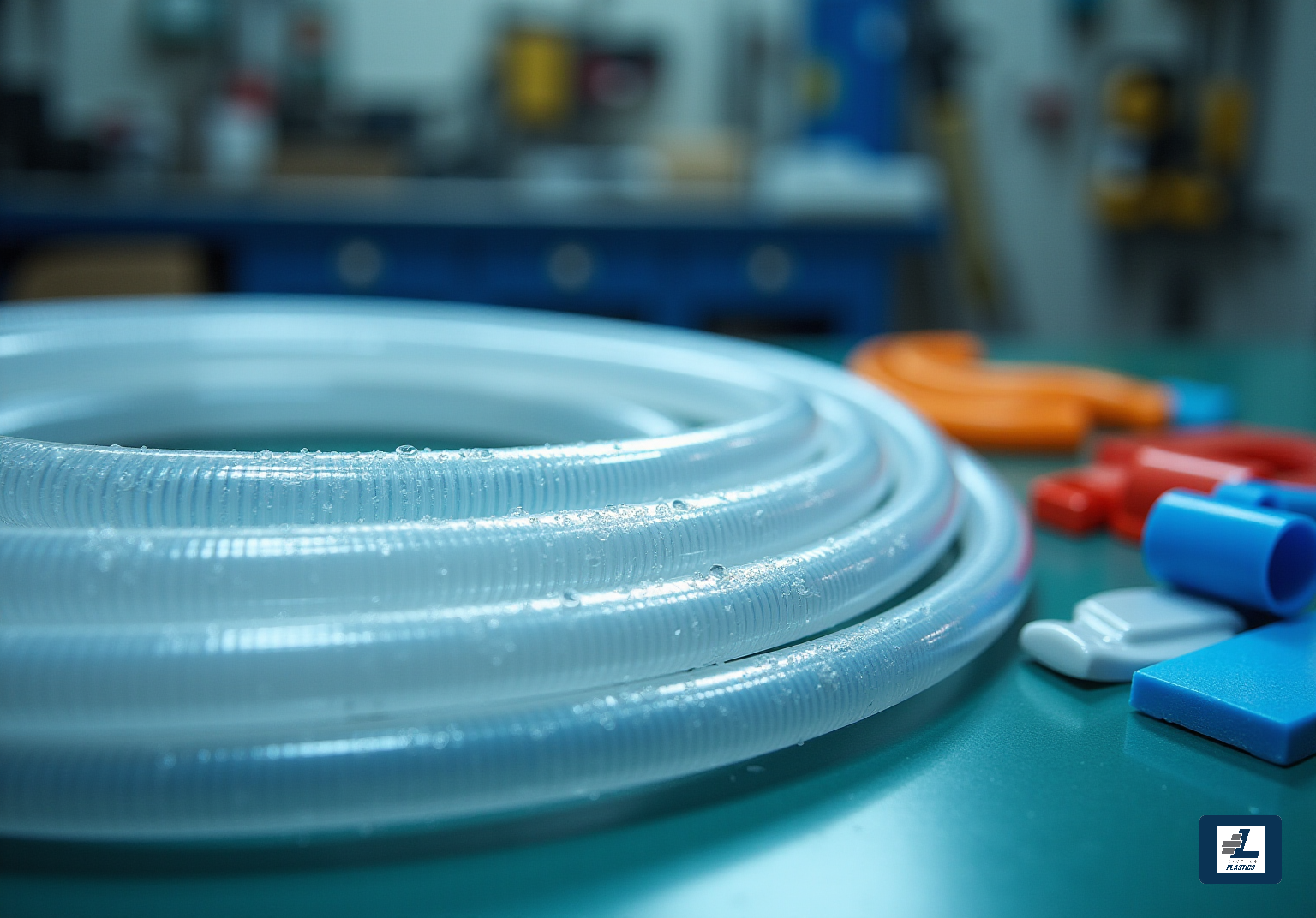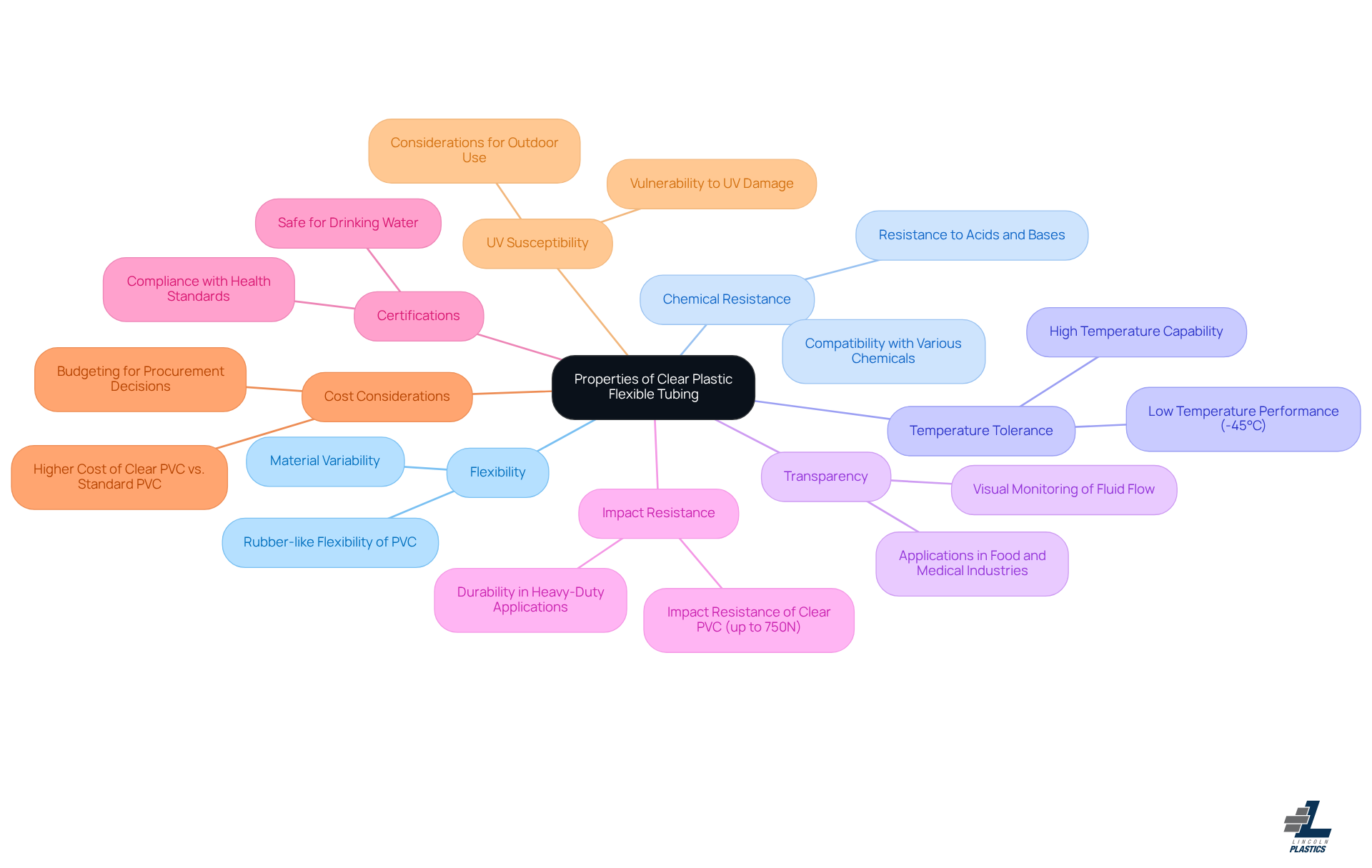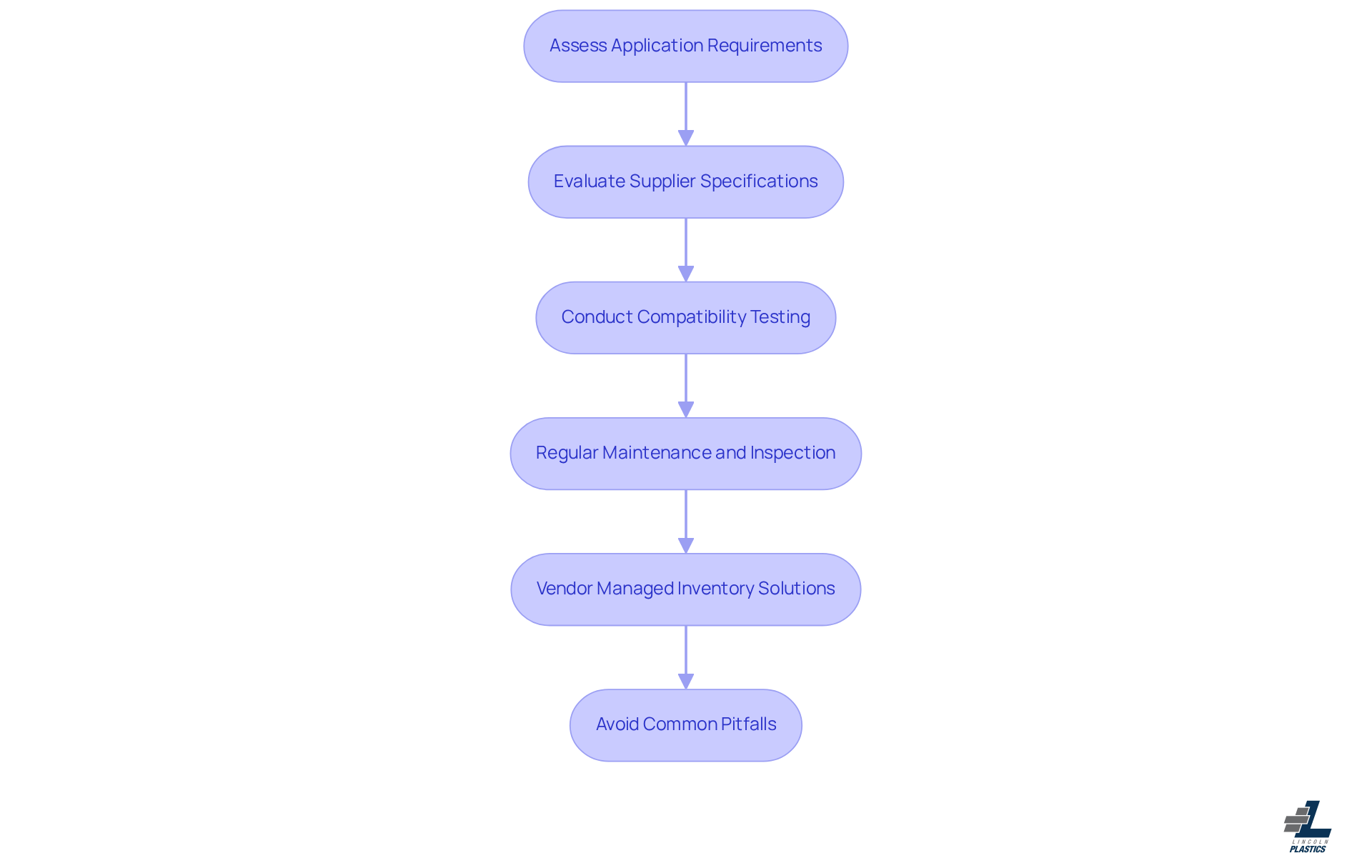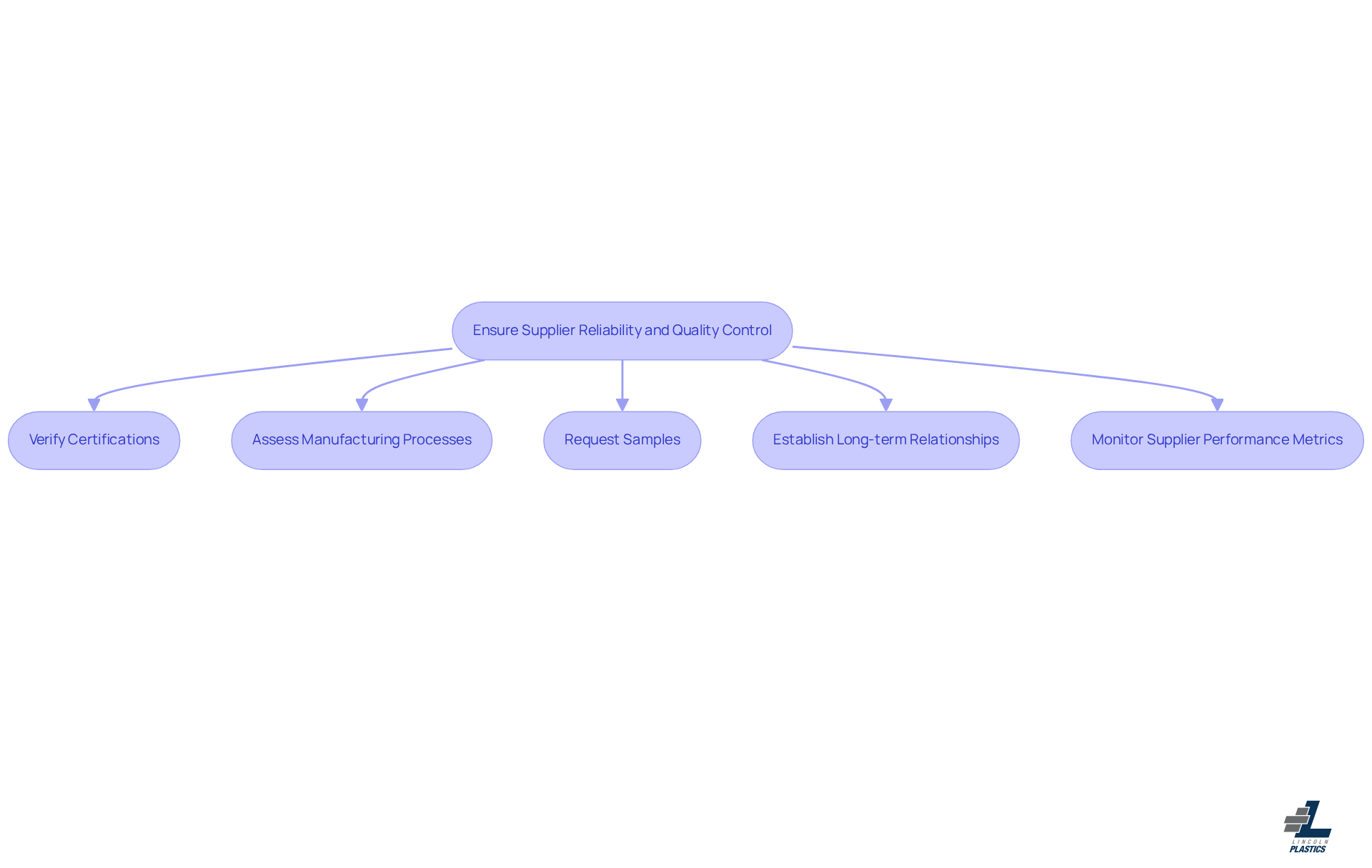
Best Practices for Clear Plastic Flexible Tubing Procurement
Overview
When it comes to procuring clear plastic flexible tubing, there are some best practices you’ll want to keep in mind. First off, understanding the material properties is key. You might be wondering how to assess your application requirements, right? Well, it’s all about ensuring that your supplier is reliable, and that’s where quality control measures come into play.
Think about it: by evaluating factors like:
- Flexibility
- Chemical resistance
- Temperature tolerance
you can really enhance the performance of your tubing solutions. And don’t forget about building strong relationships with your suppliers! Regular inspections can make a world of difference too. So, whether you’re in manufacturing or another industry, these insights can help you boost the reliability of your tubing solutions. Ready to dive in and make the most of your procurement process?
Introduction
The world of clear plastic flexible tubing is pretty vast, and it’s packed with unique properties that cater to all sorts of industrial needs. Have you ever found yourself scratching your head over materials like PVC, polyurethane, and polyethylene? Understanding these characteristics is key to making smart procurement decisions that ensure optimal performance.
But with so many options and applications—everything from food processing to medical uses—how do you navigate the complexities of choosing the right tubing? This article is here to help! We’ll dive into some best practices for procuring clear plastic flexible tubing, sharing insights that can boost reliability and efficiency. Plus, we’ll tackle the challenges of finding the right supplier and material for your specific operational requirements. So, let’s get started!
Understand the Properties of Clear Plastic Flexible Tubing
When it comes to clear plastic flexible tubing, you’ll find that they’re mainly made from materials like PVC, polyurethane, and polyethylene. Each of these has its own unique features that cater to different needs. So, what should you keep in mind?
First up, let’s talk about Flexibility. The flexibility of tubing can vary quite a bit depending on the material and thickness. This can really influence how well they fit into tight spaces or complex setups. For instance, PVC offers a rubber-like flexibility that makes it great for applications where you need a lot of movement.
Next, there’s Chemical Resistance. Different materials have varying levels of resistance to chemicals, which is super important for ensuring they can handle whatever they’re transporting. PVC shines here, known for its excellent resistance to a wide range of chemicals, while polyurethane steps it up with enhanced durability in harsher environments.
Now, let’s talk about Temperature Tolerance. It’s crucial to know the operational temperature range because some materials can degrade or lose their integrity under extreme conditions. Flexible PVC pipes, for example, keep their strength and pliability even at low temperatures, down to about -45°C. This makes them a solid choice for both cold and high-temperature situations.
What about clear plastic flexible tubing? The transparency of clear plastic flexible tubing allows you to see the fluid movement inside, which is especially important in areas like food processing and medical applications. Clear plastic flexible tubing is frequently utilized in labs for fluid transfer systems, enabling technicians to monitor flow and detect potential issues such as clogs or contamination.
Then we have Impact Resistance. Clear PVC conduit can handle impact resistance of up to 750N, making it durable and suitable for various applications.
Don’t forget about Certifications! Some PVC hoses are certified safe for drinking water, which is perfect for food and beverage processing, ensuring they meet health and safety standards.
Now, you might be wondering about Cost Considerations. It’s worth noting that clear PVC tends to be pricier than standard PVC due to extra manufacturing processes, so keep that in mind when making procurement decisions.
Lastly, let’s touch on UV Susceptibility. Clear PVC is more vulnerable to UV damage compared to standard PVC, so that’s an important factor to consider if you’re using them outdoors.
By taking a close look at these properties, you can make informed choices about which pipes will best meet your specific operational needs, ensuring you get optimal performance and reliability.

Explore Industrial Applications of Clear Plastic Flexible Tubing
Clear plastic flexible tubing finds its way into so many industries, and it’s easy to see why! Its adaptability and performance characteristics make it a go-to choice for various applications. Let’s dive into some common uses:
-
Food and Beverage: Ever noticed how clear tubing is used for transferring liquids? Its transparency not only allows for monitoring flow but also ensures product quality. Plus, it helps spot clogs or damage, which is super important for keeping things running smoothly. At Lincoln Plastics, we take this seriously—our thorough testing procedures, like dimensional evaluations and pressure assessments, guarantee that our pipes meet industry standards for safety and reliability. We’re all about assurance here!
-
Medical: In healthcare, transparent conduits play a vital role in applications like IV lines and fluid transfer. Visibility and safety are key, right? That’s why our piping goes through strict quality control measures to meet necessary health standards, ultimately boosting patient safety and compliance with regulations.
-
Aquarium and Hydroponics: If you’re into aquariums or hydroponics, you’ll appreciate how this piping is perfect for water circulation and nutrient delivery. Its flexibility and resistance to algae growth make it ideal for keeping aquatic environments healthy. Plus, we offer customization options to tailor solutions to your specific needs.
-
Chemical Processing: When it comes to transporting various chemicals, clear piping is essential. Its chemical resistance and clarity help monitor flow and prevent contamination. In labs, accurate monitoring of chemical interactions is crucial, and at Lincoln Plastics, we ensure our pipes meet high standards for dependable performance.
These applications really highlight the versatility of our pipes and the importance of choosing the right material for your operational needs. As industries evolve, the demand for high-quality clear plastic flexible tubing is only expected to grow. This is driven by their essential role in ensuring efficiency and safety, backed by our commitment to precision and rigorous quality control. So, what do you think? Ready to explore how clear plastic flexible piping can work for you?
Implement Best Practices for Selecting and Using Clear Plastic Flexible Tubing
To ensure you get the best performance from your clear plastic flexible tubing, let’s dive into some best practices that can really make a difference:
-
Assess Application Requirements: First things first, take a moment to define what you need—think about pressure, temperature, and any chemical exposure. This step is crucial for picking the right material that can handle the specific conditions of your application.
-
Evaluate Supplier Specifications: Next, check out the technical data sheets from your suppliers, like Lincoln Plastics. Understanding what the hose can and can’t do will help ensure it meets your needs, especially in tough environments where performance is key. Plus, Lincoln Plastics can help you optimize your design for manufacturing, making sure the materials fit your operational requirements.
-
Conduct Compatibility Testing: Before you go all in, it’s smart to run some compatibility tests. This way, you’ll know that the pipes work well with the fluids you plan to use and under the right conditions. It’s a vital step to avoid any failures from chemical interactions or physical stress.
-
Regular Maintenance and Inspection: Don’t forget to set up a routine inspection schedule! Keep an eye out for wear, kinks, or discoloration. These signs can point to potential failure points, allowing you to step in before issues arise and keep your piping solutions reliable.
-
Vendor Managed Inventory Solutions: Have you thought about Vendor Managed Inventory (VMI) with your supplier? By sharing your real-time inventory or weekly reports, suppliers like Lincoln Plastics can help you manage stock levels between minimums and maximums, adjusting for busy and slower seasons without needing a big warehouse.
-
Avoid Common Pitfalls: Be mindful of common mistakes, like choosing pipes without considering the specific chemical compatibility or operational conditions. These oversights can lead to premature failure and extra costs.
By following these best practices, you can significantly enhance the reliability and effectiveness of your clear plastic flexible tubing, ensuring they meet the demands of various applications across industries. So, what do you think? Ready to optimize your tubing solutions?

Ensure Supplier Reliability and Quality Control in Tubing Procurement
When searching for clear plastic flexible tubing, it’s crucial to select reliable suppliers and establish strong quality control measures. Here’s how to make that happen:
-
Verify Certifications: Look for suppliers that have industry-recognized certifications, like ISO 9001:2015. This certification shows they’re committed to management standards, which is key in the tubing manufacturing world. Take Lincoln Plastics, for example—they stick to these standards, making sure every product is thoroughly checked to meet your custom specs. Did you know that ISO 9001 certified suppliers see a 20% drop in defect rates compared to those without? That really highlights why this certification matters.
-
Assess Manufacturing Processes: Check out how your supplier manufactures their products. Are they following best practices? This means looking into their material sourcing, production methods, and testing protocols. Lincoln Plastics has a solid assurance system with dedicated standards and documentation for each product, ensuring they monitor critical dimensions and characteristics throughout production. Plus, they use various check gauges to guarantee a proper fit for your needs. Real-world examples show that ISO 9001 certified manufacturers often have rigorous inspections, leading to more reliable products.
-
Request Samples: Before you place a big order, don’t hesitate to ask for samples. This is a crucial step to see how the material performs and if it’s right for your specific applications. Catching any potential issues early can save you a lot of headaches later on.
-
Establish Long-term Relationships: Building strong partnerships with your suppliers can pay off big time. You might get better pricing, priority service, and access to innovative products. Experts say that long-term relationships with ISO 9001 certified suppliers, like Lincoln Plastics, can lead to better collaboration and innovation, benefiting everyone involved. And hey, Lincoln Plastics can easily source colors that match your Pantone specifications for consistency across manufacturers.
-
Monitor Supplier Performance Metrics: Keep an eye on key performance metrics like on-time delivery, standards, and costs. Regular evaluations are essential for effective Supplier Performance Management (SPM) and help keep those supplier relationships strong.
By putting supplier reliability and quality control at the forefront, you can effectively reduce risks in clear plastic flexible tubing procurement, ensuring consistent performance and satisfaction in your applications. So, let’s get started on making those connections!

Conclusion
Clear plastic flexible tubing is a must-have in many industries, thanks to its unique properties that meet specific operational needs. To make smart procurement decisions, it’s important to understand materials like PVC, polyurethane, and polyethylene. By looking at factors such as flexibility, chemical resistance, temperature tolerance, and impact resistance, organizations can choose the right tubing for their applications, ensuring they get the best performance and reliability.
Now, let’s dive into some best practices for selecting and using clear plastic flexible tubing. It’s crucial to:
- Assess your application requirements
- Evaluate supplier specifications
- Conduct compatibility testing
- Keep up with regular inspections
These steps can really boost the effectiveness of your tubing solutions. Plus, building strong relationships with reliable suppliers who follow quality control standards can help you avoid risks in procurement.
Ultimately, we can’t underestimate the importance of clear plastic flexible tubing in keeping efficiency and safety at the forefront across various applications. As industries evolve, embracing these best practices will not only enhance operational outcomes but also spark innovation and collaboration within supply chains. By focusing on informed choices and supplier reliability, organizations can thrive in their fields while upholding the highest standards of quality and performance.
Frequently Asked Questions
What materials are commonly used to make clear plastic flexible tubing?
Clear plastic flexible tubing is mainly made from materials like PVC, polyurethane, and polyethylene, each with unique features catering to different needs.
How does the flexibility of clear plastic tubing vary?
The flexibility of tubing can vary significantly depending on the material and thickness. PVC offers a rubber-like flexibility, making it suitable for applications requiring a lot of movement.
What is the importance of chemical resistance in clear plastic tubing?
Different materials have varying levels of chemical resistance, which is crucial for ensuring the tubing can handle the substances they transport. PVC is known for excellent resistance to a wide range of chemicals, while polyurethane offers enhanced durability in harsher environments.
What are the temperature tolerance ranges for clear plastic flexible tubing?
It's important to know the operational temperature range of the materials. Flexible PVC pipes maintain strength and pliability even at low temperatures, down to about -45°C, making them suitable for both cold and high-temperature situations.
Why is transparency important in clear plastic flexible tubing?
The transparency of clear plastic flexible tubing allows for monitoring fluid movement inside, which is essential in applications like food processing and medical settings to detect potential issues such as clogs or contamination.
How does clear plastic flexible tubing handle impact resistance?
Clear PVC conduit can withstand impact resistance of up to 750N, making it durable and suitable for various applications.
Are there certifications for clear plastic flexible tubing?
Some PVC hoses are certified safe for drinking water, making them ideal for food and beverage processing as they meet health and safety standards.
What are the cost considerations when selecting clear plastic flexible tubing?
Clear PVC tends to be more expensive than standard PVC due to additional manufacturing processes, so this should be considered during procurement decisions.
How does UV susceptibility affect the use of clear plastic flexible tubing?
Clear PVC is more vulnerable to UV damage compared to standard PVC, which is an important factor to consider if the tubing will be used outdoors.
List of Sources
- Understand the Properties of Clear Plastic Flexible Tubing
- PVC Tubing | Clear & Vinyl Tubing Supplier (https://piedmontplastics.com/products/pvc-tubing?srsltid=AfmBOopKGa0W5B9ICyWgDJRl-MRybzIC0rUTArQ2DwvEiYgPfvvWP_k9)
- Characteristics, Benefits, and Applications of PVC Tubing (https://iqsdirectory.com/articles/plastic-tubing/pvc-tubing.html)
- What Is Clear PVC Pipe? Everything You Need To Know | Ctube (https://ctube-gr.com/news/what-is-clear-pvc-pipe.html)
- 7 Great Benefits of PVC Tube & Hose | Abbey Extrusions (https://abbeyextrusions.com/news/seven-great-benefits-of-pvc-tube-hose)
- DIFFERENCES BETWEEN POLYETHYLENE AND POLYURETHANE PLASTIC TUBING (https://seilerpc.com/differences-between-polyethylene-and-polyurethane-plastic-tubing)
- Explore Industrial Applications of Clear Plastic Flexible Tubing
- The Diverse Applications and Significance of Transparent PVC Tubing (https://kebinghose.com/news/the-diverse-applications-and-significance-of-transparent-pvc.html)
- Ethyl Vinyl Acetate Tubing Market (https://linkedin.com/pulse/ethyl-vinyl-acetate-tubing-market-marketshift-research-kzrwc)
- Plastics in the health sector | Health Care Without Harm - Global (https://global.noharm.org/focus/plastics/case_studies)
- News - What PVC Hoses’ Application and Benefits ? (https://inpvc.com/news/what-pvc-hoses-application-and-benefits)
- Implement Best Practices for Selecting and Using Clear Plastic Flexible Tubing
- Polymeric Materials Selection for Flexible Pulsating Heat Pipe Manufacturing Using a Comparative Hybrid MCDM Approach (https://mdpi.com/2073-4360/15/13/2933)
- Designs and Applications of Plastic Tubing (https://iqsdirectory.com/articles/plastic-tubing.html)
- Custom Plastic Tubing | Flexible, Semi-Rigid or Rigid (https://plasticextrusiontech.net/capabilities/plastic-tubing)
- Plastics in the health sector | Health Care Without Harm - Global (https://global.noharm.org/focus/plastics/case_studies)
- Ensure Supplier Reliability and Quality Control in Tubing Procurement
- 11 Statistics On Supplier Sourcing You Need to Know - Veridion (https://veridion.com/blog-posts/supplier-sourcing-statistics)
- Supplier Performance Management Metrics and Frameworks Explained (https://artofprocurement.com/blog/learn-supplier-performance-management-metrics)


